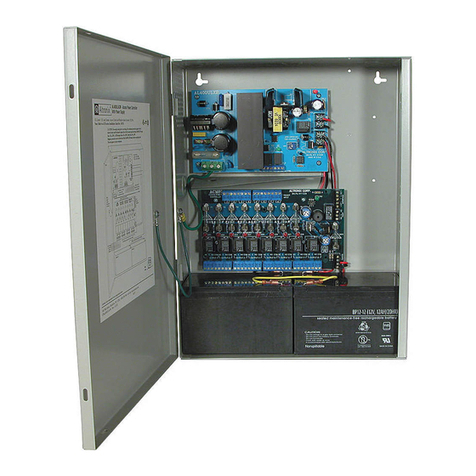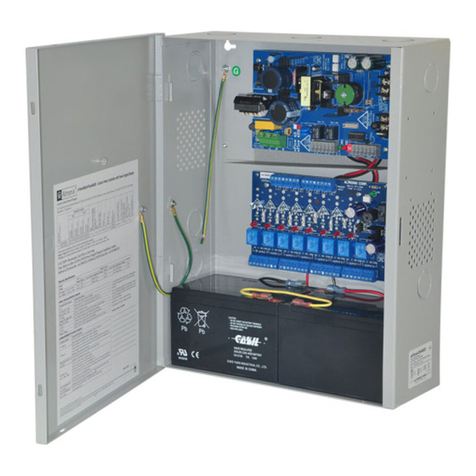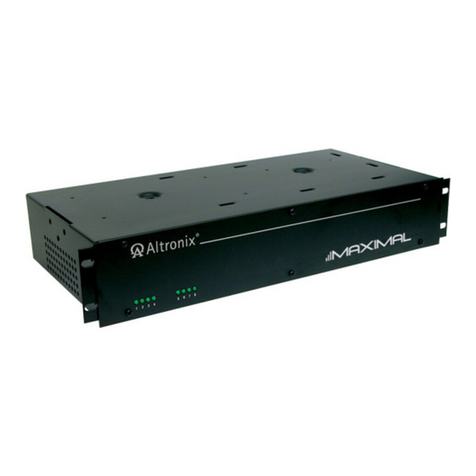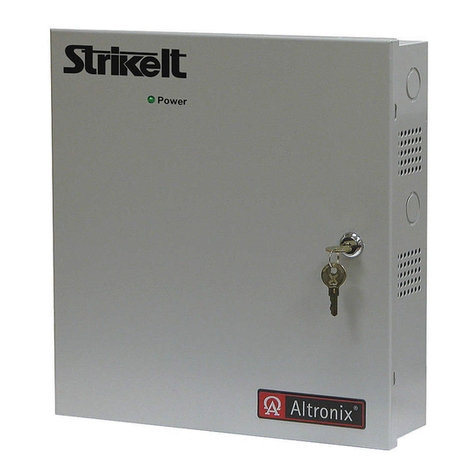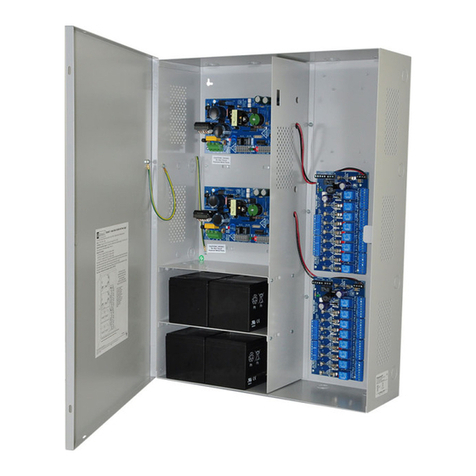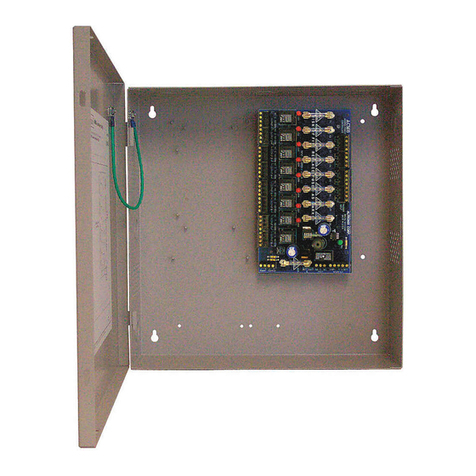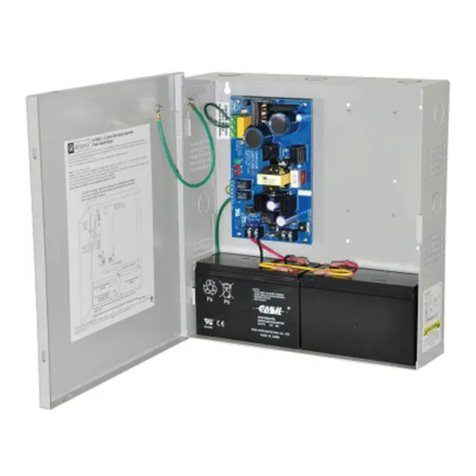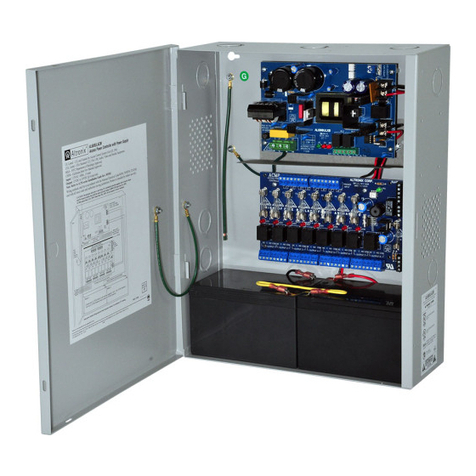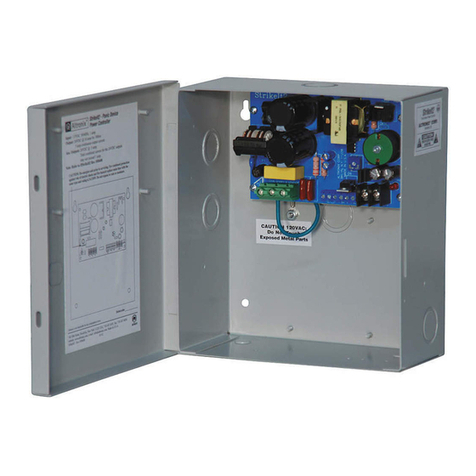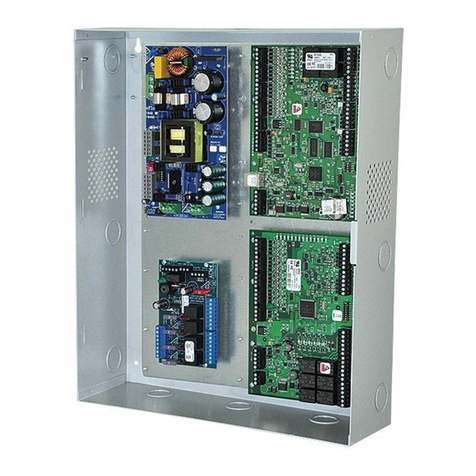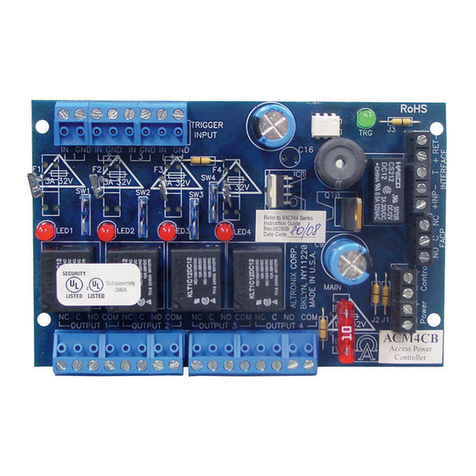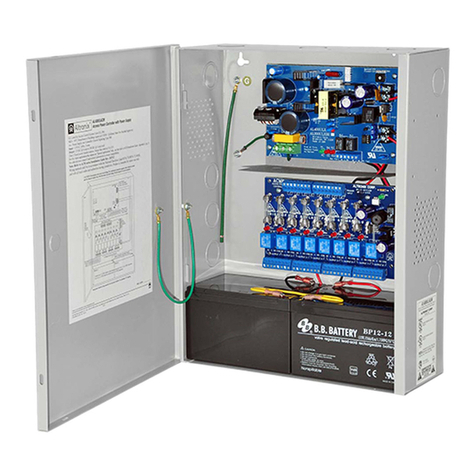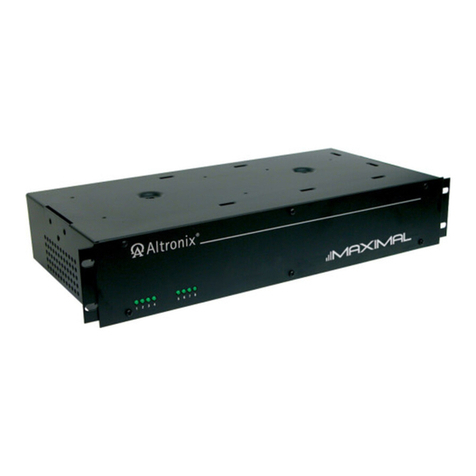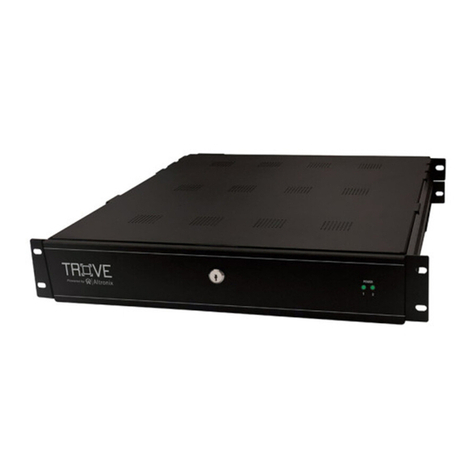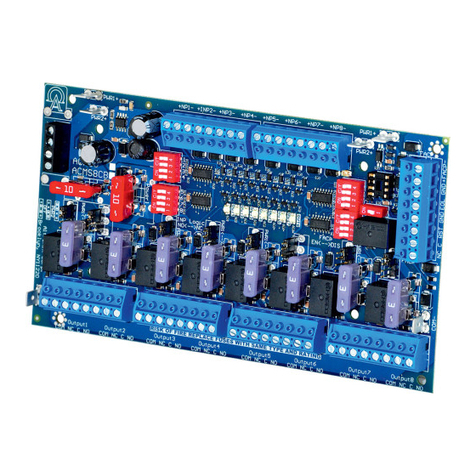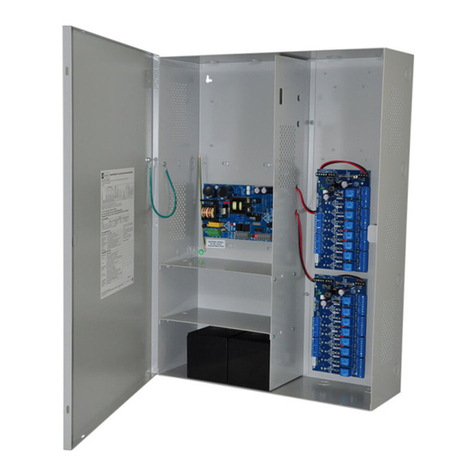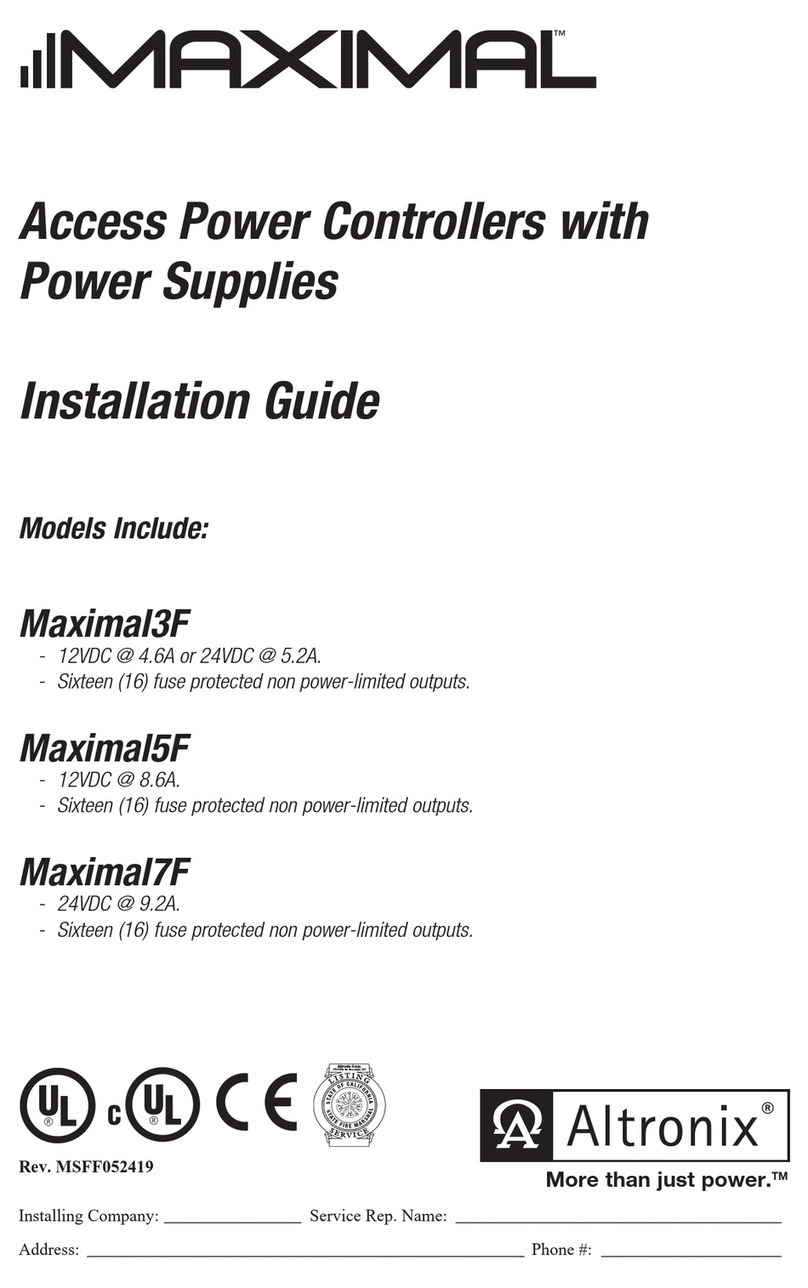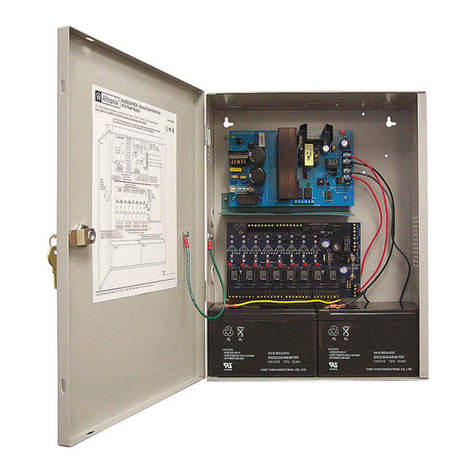
- 6 - Maximal3FD/Maximal5FD/Maximal7FD Access Power Controllers (PTC)
(b) Normally Closed [NC] input:
For non-latching hook-up refer to Fig. 8, pg. 12. For latching hook-up refer to Fig. 9, pg. 12.
(c) FACP Signaling Circuit input trigger:
Connect the positive (+) and negative (–) from the FACP signaling circuit output to the terminals
marked [+ INP –]. Connect the FACP EOL to the terminals marked [+ RET –] (polarity is referenced
in an alarm condition). Jumper located next to TRG LED must be cut (Fig. 2a, pg. 9 and Fig. 5, pg. 12).
9. FACP Dry form “C” output (not evaluated by UL) (Fig. 2b, pg. 9):
FACP form “C” contacts can be use to trigger reporting or signaling devices. These contact switch
upon a fire alarm input trigger to the ACM8CB boards.
10. Stand-by Battery Connections (Fig. 3, pg. 10):
For U.S. Access Control applications batteries are optional. Batteries are required for Canadian installations
(ULC-S319). When batteries are not used, a loss of AC will result in the loss of output voltage. When the
use of stand-by batteries is desired, they must be lead acid or gel type. Connect battery to terminals marked
[– BAT +] (Fig. 3, pg. 10). Use two (2) 12VDC batteries connected in series for 24VDC operation (battery
leads included). Use batteries - Casil CL1270 (12V/7AH), CL12120 (12V/12AH), CL12400 (12V/40AH),
CL12650 (12V/65AH) batteries or UL recognized BAZR2 and BAZR8 batteries of an appropriate rating.
11. Battery and AC Supervision outputs (Fig. 3, pg. 10):
It is required to connect supervisory trouble reporting devices to outputs marked [AC Fail, BAT Fail]
supervisory relay outputs marked [NC, C, NO] to appropriate visual notification devices.
Use 22 AWG to 18 AWG for AC Fail and Low/No Battery reporting.
12. To delay AC reporting for 2 hrs., set DIP switch [AC Delay] to OFF position (Fig. 3, pg. 10).
To delay AC reporting for 1 min., set DIP switch [AC Delay] to ON position (Fig. 3, pg. 10).
13. Fire Alarm Disconnect (Fig. 3, pg. 10):
To enable Fire Alarm Disconnect set DIP switch [Shutdown] to ON position.
To disable Fire Alarm Disconnect set DIP switch [Shutdown] to OFF position.
14. Installation of Tamper Switch (Fig. 3b, pg. 10):
Mount UL Listed tamper switch (Altronix model TS112 or equivalent) at the top of the enclosure. Slide the
tamper switch bracket onto the edge of the enclosure approximately 2” from the right side (Fig. 3b, pg. 10).
Connect tamper switch wiring to the Access Control Panel input or the appropriate UL Listed reporting
device. To activate alarm signal, open the door of the enclosure.
15. Multiple power supply inputs (Fig. 2, pg. 9) (Not evaluated by UL):
When using an additional Listed external power supply, jumpers J1 and J2 located on corresponding
ACM8CB board must be cut (Fig. 2c, pg. 9 and Fig. 5, pg. 12). Connect external Listed power-limited
access control power supply to the terminals marked [– Control +] (These terminals are paralleled to the
[– Power +] terminals). When using DC power supplies, polarity must be observed. When using AC
power supplies, polarity need not be observed (Fig. 2d, pg. 9). All field wiring connections must be made
employing suitable gauge CM or FPL jacketed wire (or equivalent substitute) (Fig. 4a, pg. 11).
Maintenance:
Unit should be tested at least once a year for the proper operation as follows:
FACP Supervision:
To ensure proper connection and operation of the Fire Alarm disconnect hookup, please follow the
appropriate procedure below:
Normally Open Input: Placing a short between terminals marked [T] and [+ INP] will trigger the Fire
Alarm Disconnect. Remove the short to reset.
Normally Closed Input: Removing the wire from terminal marked [INP –] will trigger the Fire Alarm
Disconnect. Replace the wire to terminal marked [INP –] to reset.
FACP Signal Circuit Input: It is necessary to trigger the Fire Alarm System.
In all of the above scenarios the green TRG LED of the ACM8CBs will illuminate. All outputs selected for
Fire Alarm Disconnect will activate releasing locking devices.
Note: All outputs [OUT 1] - [OUT 8] must be in a normal (de-energized) condition prior to testing. When
the unit is configured for Normally Open (Fig. 7, pg. 12) or Normally Closed (Fig. 9, pg. 12) latching
operation it is necessary to reset the Fire Alarm Disconnect by activating the Normally Closed reset switch.
Output Voltage Test: Under normal load conditions, the DC output voltage should be checked for proper
voltage level (refer to MaximalFD series Configuration Chart, pg. 3).
Battery Test: Under normal load conditions check that the battery is fully charged, check specified voltage at
the battery terminals and at the board terminals marked [+ BAT –] to ensure that there is no break in the battery
connection wires.
Note: Maximum charge current is 1.54A.
